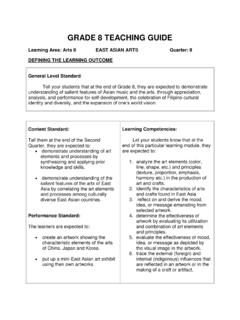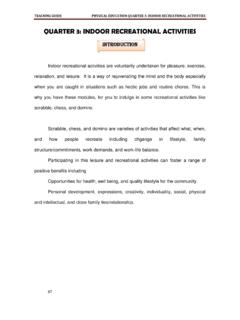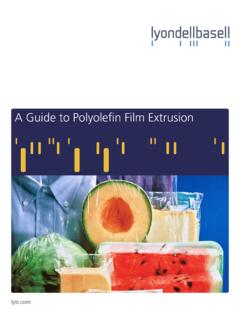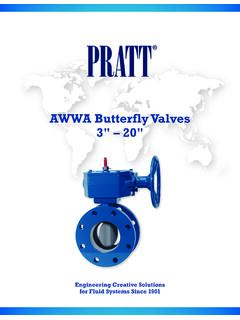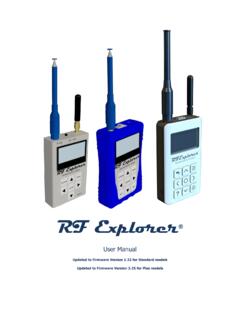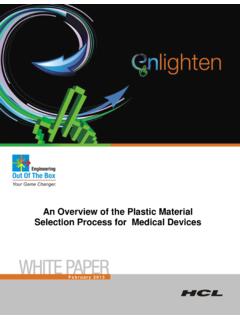Transcription of Technology and Livelihood Education Learning Module
1 K to 12 Basic Education Curriculum Technology and Livelihood Education Learning Module BREAD AND PASTRY PRODUCTION EXPLORATORY COURSE Grades 7 and Grade 8 Republic of the Philippines DEPARTMENT OF Education BREAD AND PASTRY PRODUCTION NC II K to 12 Technology and Livelihood Education 1 1 TABLE OF CONTENTS What Is This Module About ? .. 2 How Do You Use This Module .. 3 LESSON 1 Use Tools and Bakery Equipment .. 4 LESSON 2 Perform Mensuration and 20 LESSON 3 Maintain Tools and Equipment .. 36 LESSON 4 Practice Occupational Health and Safety Procedures .. 58 Answer Keys .. 122 List of Materials/Tools/Equipment /Consumables for this Module .. 131 Acknowledgment .. 132 BREAD AND PASTRY PRODUCTION NC II K to 12 Technology and Livelihood Education 2 2 Welcome to the world of Bread and Pastry Production! This Module is an exploratory course which leads you to Bread and Pastry Production National Certificate Level II ( NC II)1.
2 It covers 4 common competencies that a Grade 7 / Grade 8 Technology and Livelihood Education (TLE) student like you ought to possess, namely: 1. use of tools and bakery equipment; 2. mensuration and calculation; 3. maintain tools and equipment; and 4. practice occupational health and safety procedures. These 4 common competencies are covered separately in 4 Lessons. As shown below, each Lesson is directed to the attainment of one, two, three or four Learning outcomes: Lesson 1 Using of Tools and Bakery Equipment LO1. Prepare tools and equipment for specific baking purposes. Lesson 2 Performing Mensuration and Calculation LO 1. Familiarize oneself with the table of weights and measures in baking. LO 2. Apply basic mathematical operations in calculating weights and measures. LO 3. Measure dry and liquid ingredients accurately. Lesson 3 Maintaining Tools and Equipment LO 1.
3 Check condition of tools and equipment. LO 2. Perform basic preventive. LO 3. Store tools and equipment. Lesson 4 Practice Occupational Health and Safety Procedure LO 1. Identify hazards and risks. LO 2. Evaluate hazards and risks. LO 3. Control hazards and risks. LO 4. Maintain occupational health and safety awareness. Your success in this exploratory course on Bread and Pastry Production is shown in your ability to perform the performance standards found in each Lesson. 1 NATIONAL CERTIFICATE (NC) is a certification issued to individuals who achieved all the required units of competency for a national qualification as defined under the Training Regulations. NCs are aligned to specific levels within the PTQF. (TESDA Board Resolution No. 2004-13, Training Regulations Framework) NATIONAL CERTIFICATE LEVEL refers to the four (4) qualification levels defined in the Philippine TVET Qualifications Framework (PTQF) where the worker with: a.
4 NC I performs a routine and predictable tasks; has little judgment; and, works under supervision; b. NC II performs prescribed range of functions involving known routines and procedures; has limited choice and complexity of functions, and has little accountability; What Is This Module About? BREAD AND PASTRY PRODUCTION NC II K to 12 Technology and Livelihood Education 3 3 This Module has 4 Lessons. Each Lesson has the following parts. Learning Outcomes Performance Standards Materials/Resources Definition of Terms What Do You Already Know? What Do You Need to Know? How Much Have You Learned? How Do You Apply What You Learned? How Well Did You Perform? How Do You Extend Your Learning ? References To get the most from this Module , do the following. 1. Read the Learning Outcome/s and Performance Standards. These tell you what you should know and be able to do at the end of this Module . 2.
5 Find out what you already know by taking the Pretest then check your answer against the Answer Key. If you get 99 to 100% of the items correctly, you may proceed to the next Lesson. This means that you need not go through the Lesson because you already know what it is about. If you failed to get 99 to 100% correctly, go through the Lesson again and review especially those items which you failed to get. 3. Accomplish the required Learning Activities. They begin with one or more Information Sheets. An Information Sheet contains important notes or basic information that you need to know. After reading the Information Sheet, test yourself on how much you learned by means of the Self-check. Refer to the Answer Key for correction. Do not hesitate to go back to the Information Sheet when you do not get all test items correctly. This will ensure your mastery of basic information.
6 4. Demonstrate what you learned by doing what the Activity/Operation/Job Sheet directs you to do. 5. You must be able to apply what you have learned in another activity or in real life situation. 6. Accomplish the Scoring Rubrics for you to know how well you performed. Each Lesson also provides you with references and definition of key terms for your guide. They can be of great help. Use them fully. How Do You Use This Module ? If you have questions, ask your teacher for assistance. BREAD AND PASTRY PRODUCTION NC II K to 12 Technology and Livelihood Education 4 4 . Use tools and bakery equipment LESSON 1 LO 1. prepare tools and equipment for specific baking purposes. Learning OUTCOMES: At the end of this Lesson, you are expected to do the following: BREAD AND PASTRY PRODUCTION NC II K to 12 Technology and Livelihood Education 5 5 Baking the process of cooking food by indirect heat or dry heat in a confined space as in heated oven using gas, electricity, charcoal, wood, or oil at a temperature from 250 oF- 450 oF Batter a flour mixture that can be stirred or poured Convection oven stove in which a fan circulates heated air through the oven for fast, even cooking.
7 Discard to get rid of as of being no further use Dough a flour mixture that can be rolled or kneaded Dutch oven a brick oven Igniter the carborundum rod used to initiate the discharge in an ignitron tube Microwave oven an oven that utilizes electromagnetic energy below the magnetic spectrum Mixing to bring together into uniform mass Pre-heat to heat (an oven, for example) before hand Sift separating course particles in the ingredient by passing through a sieve or sifter Definition of Terms BREAD AND PASTRY PRODUCTION NC II K to 12 Technology and Livelihood Education 6 6 Direction: Match column A with Column B. Write the letters only. A. B 1. used for baking loaf bread a. wooden spoon 2. has sloping sides used for mixing ingredients and comes in graduated sizes b.
8 Pastry blender 3. a stack oven c. mixing bowls 4. used for cutting biscuit or doughnuts d. pastry wheel 5. used to hold ingredients together e. spatula 6. it is also called mixing spoon f. egg beater 7. used for cutting fat with flour in the preparation of pies and pastries g. doughnut cutter 8. used for beating eggs or whipping cream h. deck oven 9. use for cutting dough when making pastries i. loaf pan 10. used for icing cakes j. utility tray What Do You Already Know? Prepare tools and equipment for specific baking purpose Learning OUTCOME 1 Pretest LO 1 Let us determine how much you already know about preparing tools and equipment. Take this test. Baking tools and equipment are identified based on their uses. PERFORMANCE STANDARDS BREAD AND PASTRY PRODUCTION NC II K to 12 Technology and Livelihood Education 7 7 1.
9 Baking wares are made of glass or metal containers for batter and dough with various sizes and shapes. Cake pans - comes in different sizes and shapes and may be round square rectangular or heart shaped. 1. Tube center pan deeper than a round pan and with a hollow center, it is removable which is used to bake chiffon type cakes 2. Muffin pan - has 12 formed cups for baking muffins and cup cakes 3. Pop over pan is used for cooking pop over 4. Jelly roll pan is shallow rectangular pan used for baking rolls 5. Bundt pan is a round pan with scalloped sides used for baking elegant and special cakes 6. Custard cup is made of porcelain or glass used for baking individual custard What Do You Need To Know? Information Sheet Read Information Sheet very well then find out how much you can remember and how much you learned by doing Self-check BAKING TOOLS AND EQUIPMENT AND THEIR USES BREAD AND PASTRY PRODUCTION NC II K to 12 Technology and Livelihood Education 8 8 7.
10 Griddle pans are used to bake griddles 8. Loaf Pan is used to bake loaf bread 2. Biscuit and doughnut cutter is used to cut and shape biscuit or doughnut. 3. Cutting tools include a knife and chopping board that are used to cut glazed fruit, nuts, or other ingredients in baking. 4. Electric mixer is used for different baking procedure for beating, stirring and blending. 5. Flour sifter is used for sifting flour. 6. Grater is used to grate cheese, chocolate, and other fresh fruits. 7. Kitchen shears - are used to slice rolls and delicate cakes. 8. Measuring cups consist of two types namely: a. A graduated cup with fractions (1, 3/4, 2/3, , 1/3, , 1/8) marked on each side. b. A measuring glass made of transparent glass or plastic is more accurate for measuring. 9. Measuring spoons consist of a set of measuring spoons used to measure small quantities of ingredients.


